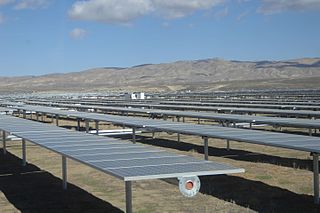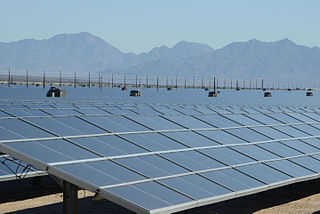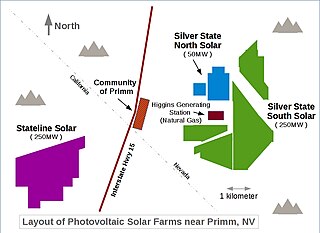
Solar Energy Generating Systems (SEGS) is a concentrated solar power plant in California, United States. With the combined capacity from three separate locations at 354 megawatt (MW), it was once the world's second largest solar thermal energy generating facility, until the commissioning of the even larger Ivanpah facility in 2014. It consisted of nine solar power plants in California's Mojave Desert, where insolation is among the best available in the United States.

The SOLAR Project consists of the Solar One, Solar Two and Solar Tres solar thermal power plants based in the Mojave Desert, United States and Andalucía, Spain. The US Department of Energy (DOE) and a consortium of US utilities built the country's first two large-scale, demonstration solar power towers in the desert near Barstow, California.

There are several solar power plants in the Mojave Desert which supply power to the electricity grid. Insolation in the Mojave Desert is among the best available in the United States, and some significant population centers are located in the area. These plants can generally be built in a few years because solar plants are built almost entirely with modular, readily available materials. Solar Energy Generating Systems (SEGS) is the name given to nine solar power plants in the Mojave Desert which were built in the 1980s, the first commercial solar plant. These plants have a combined capacity of 354 megawatts (MW) which made them the largest solar power installation in the world, until Ivanpah Solar Power Facility was finished in 2014.

Solar power includes solar farms as well as local distributed generation, mostly on rooftops and increasingly from community solar arrays. In 2022, utility-scale solar power generated 145.6 terawatt-hours (TWh), or 3.4% of electricity in the United States. Total solar generation that year, including estimated small-scale photovoltaic generation, was 204 TWh.

Topaz Solar Farm is a 550 megawatt (MWAC) photovoltaic power station in San Luis Obispo County, California, United States. Construction on the project began in November 2011 and ended in November 2014. It is one of the world's largest solar farms. The $2.5 billion project includes 9 million CdTe photovoltaic modules based on thin-film technology, manufactured by U.S. company First Solar. The company also built, operates and maintains the project for MidAmerican Renewables, a Berkshire Hathaway company. Pacific Gas and Electric will buy the electricity under a 25-year power purchase agreement. According to First Solar, it created about 400 construction jobs.

The California Valley Solar Ranch (CVSR) is a 250 megawatt (MWAC) photovoltaic power plant in the Carrizo Plain, northeast of California Valley. The project is owned by NRG Energy, and SunPower is the EPC contractor and technology provider. The project constructed on 1,966 acres (796 ha) of a 4,365-acre (1,766 ha) site of former grazing land. It is utilizing high-efficiency, crystalline PV panels designed and manufactured by SunPower. The project includes up to 88,000 SunPower solar tracking devices to hold PV panels that track the sun across the sky.

Solar power has been growing rapidly in the U.S. state of California because of high insolation, community support, declining solar costs, and a renewable portfolio standard which requires that 60% of California's electricity come from renewable resources by 2030, with 100% by 2045. Much of this is expected to come from solar power via photovoltaic facilities or concentrated solar power facilities.

Sierra SunTower was a 5 MW commercial concentrating solar power (CSP) plant built and operated by eSolar. The plant is located in Lancaster, California. As of mid-September, 2022, the two towers that were the center of the facility are no longer standing. However the rest of the plant is still present.

The Blythe Mesa Solar Power Project, also known as the Blythe Solar Energy Center, is a 235 megawatt (MWAC) photovoltaic power plant near the city of Blythe in Riverside County, California. It occupies about 2,000 acres of public land managed by the Bureau of Land Management in the Mojave Desert. The construction uses CdTe thin film panels from the U.S. firm First Solar, and the majority of the output is being sold to Kaiser Permanente and Southern California Edison under 20-year power purchase agreements.
The 21 megawatt Blythe Photovoltaic Power Plant is a photovoltaic (PV) solar project in California. It is located in Blythe, California, in Riverside County about 200 miles (320 km) east of Los Angeles. Commercial operation began in December 2009. Electricity generated by the power plant is being sold to Southern California Edison under a 20-year power purchase agreement. Another 20 MW plant called NRG Solar Blythe II came online in April 2017.

The Copper Mountain Solar Facility is a 802 megawatt (MWAC) solar photovoltaic power plant in Boulder City, Nevada, United States. The plant was developed by Sempra Generation. When the first unit of the facility entered service on December 1, 2010, it was the largest photovoltaic plant in the U.S. at 58 MW. With the opening of Copper Mountain V in March 2021, it again became the largest in the United States. It is co-located with the 64 MW Nevada Solar One, 150 MW Boulder Solar, and 300 MW Techren Solar projects in the Eldorado Valley, thus forming a more than 1 gigawatt (GW) solar generating complex. By comparison, generating capacity at the nearby Hoover Dam is about 2 GW.

The Desert Sunlight Solar Farm is a 550-megawatt (MWAC) photovoltaic power station approximately six miles north of Desert Center, California, United States, in the Mojave Desert. It uses approximately 8.8 million cadmium telluride modules made by the US thin-film manufacturer First Solar. As of Fall 2015, the Solar Farm has the same 550 MW installed capacity as the Topaz Solar Farm in the Carrizo Plain region of Central California, making both of them tied for the second largest completed solar plants by installed capacity.
The Avenal Solar Facility is a 57.7 megawatt (MW) photovoltaic power station in Kings County, California, constructed using 450,900 SHARP-128W thin-film modules. At its completion, it was California's largest photovoltaic facility.
The Antelope Valley Solar Ranch 1 (AVSR1) is a 230 megawatt (MWAC) photovoltaic power plant near Lancaster within Antelope Valley, in the western Mojave Desert, Southern California. It uses cadmium telluride modules made by the US thin-film manufacturer First Solar. The project was developed by First Solar and later bought by Exelon Corporation in 2011. The solar facility was fully commissioned in April 2014.
The McCoy Solar Energy Project is a 250 megawatt (MWAC) photovoltaic power plant near the city of Blythe in Riverside County, California. It occupies about 2,300 acres of mostly public land in the Mojave Desert. The construction uses CdTe thin film panels from First Solar, and the output is being sold to Southern California Edison under a power purchase agreement.
Mount Signal Solar, also known as Imperial Valley Solar Project, is a 794 MWp (614 MWAC) photovoltaic power station west of Calexico, California, United States, in the southern Imperial Valley, near the Mexican border. The facility is being developed and constructed by 8minutenergy Renewables in three phases, with two completed as of 2018. At full build-out, it will be one of the world's largest PV solar farms with a capacity of about 800 MWp (600 MWAC). The project has been supported by several environmental groups, as the power station was built on low productivity farmland.
Solar Star is a 579-megawatt (MWAC) photovoltaic power station near Rosamond, California, United States, that is operated and maintained by SunPower Services. When completed in June 2015, it was the world's largest solar farm in terms of installed capacity, using 1.7 million solar panels, made by SunPower and spread over 13 square kilometers.
The Springbok Solar Farm is a 443 MWp (350 MWAC) photovoltaic power station in the northwestern Mojave Desert, near California City in eastern Kern County, California. The facility was developed and constructed by 8minutenergy Renewables in three phases. It is among the country's largest PV solar farms with a capacity of about 440 MWp (350 MWAC).

Desert Stateline Solar Facility is a 300 MWp utility-scale solar photovoltaic power station constructed by First Solar in San Bernardino County in California, USA. It is located at the base of Clark Mountain in California, across the state line from Primm, Nevada, and adjacent to the Ivanpah Solar Power Facility.
The Moapa Southern Paiute Solar Project is a 250 megawatt (MWAC) photovoltaic power plant located in Clark County, Nevada on the Moapa River lands of the Southern Paiute people. The project was commissioned in March 2017 and was constructed by First Solar and its sub-contractors in close consultation with the Moapa Band of Paiutes and federal agencies. It is the first utility-scale solar project to be located on North American tribal lands, and is anticipated to evolve as a model for similar future economic and environmental partnerships.










